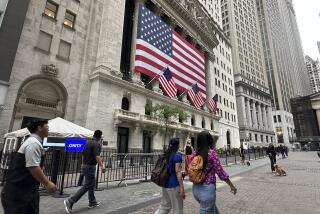‘Blood Bath’ in Bank Stocks May Get Worse : Wall Street: Investors are worried about bad debts accumulated by banks and thrifts in the real estate market.
- Share via
Worries about a slowing economy and increasing loan losses have pummeled bank and thrift stocks during the past two months, causing several issues to dive dramatically. And the worst may not be over, according to some analysts.
“It’s been a blood bath,” said Frank DeSantis, bank analyst with Paine Webber & Co. in New York. “Of the 49 (banks) we follow at Paine Webber, only four are up since Sept. 30. The rest are down.”
First Interstate Bancorp’s announcement Thursday that it would set aside $400 million largely to rid itself of troubled Texas assets--a move expected to result in a substantial fourth-quarter loss--may exacerbate the stock slide, analysts said.
“It raises worries about where the next problem is going to come from,” said Stephen Berman, bank analyst with County Securities in New York.
“The psychology of this market causes any announcement like this to hurt other stocks,” DeSantis added. “There is a real paranoia about the real estate market.”
The decline follows several months of increases in the financial group. Savings and loan stocks in particular skyrocketed in the early part of the year because of changing rules that helped healthy thrifts. Meanwhile, bank stocks got a lift from falling interest rates. Banks and thrifts generally benefit when interest rates fall.
In the early part of the year, for example, the shares of some healthy thrifts soared 60% to 70%.
However, since the end of September, share prices of even the healthiest companies have fallen by an average of 17%, compared to a fall of 4.7% in the Standard & Poor’s 500-stock index, said Jim Wilson, thrift analyst with Montgomery Securities in San Francisco.
Analysts blame the current slide on continuing revelations of trouble in bank and thrift loan portfolios since midyear. Earlier this year, several big banks--including First Interstate--said they would set aside large reserves to cover unexpected loan losses in Arizona, where real estate values have declined precipitously. Thrifts, including Great Western and Home Federal, said they also would add to reserves for out-of-state loans.
That fueled fears that the economy is souring, which could further erode real estate prices. And investors worry that a significant drop in real estate prices could push up bank foreclosures, analysts said.
Moreover, financial companies have posted lackluster quarterly results even though other market conditions should be working in their favor, Berman said. Recent declines in interest rates should have helped banks and thrifts, but financial institutions have yet to show significantly improved earnings, he added.
Some of the drop also reflects new realities in the industry, which is expected to face tougher times as regulations tighten and competition increases.
The market slide has hit nearly all financial companies regardless of their strength, Berman said.
Indeed, a sampling of 20 of the nation’s largest banks and thrifts indicates that all have seen their stock prices erode during the past two months. Even stocks of strong banks, such as J. P. Morgan, Security Pacific and Wells Fargo, have suffered, each losing 7% to 16% of their Sept. 30 values.
At less healthy companies, including several thrifts, the price declines have been more dramatic. The stock price of Columbia Savings & Loan, for example, has fallen more than 60% in the past two months. Imperial Savings’ stock is down 54%, Great American Savings is off 47% and GlenFed Inc.’s price slid 36% since Sept. 30.
First Interstate is also among the hard hit. After it announced plans to set aside $400 million, investors knocked $3.50 off its stock Thursday and an additional $2.50 Friday to a close of $45.75 per share on the New York Stock Exchange.
That drop couldn’t have come at a worse time. The Los Angeles-based banking company plans to raise $400 million in a stock offering to replenish its capital, but the decline means that it may have to sell more stock than it had intended, analysts said.
Still, analysts said, current prices for financial stocks indicate that Wall Street has overreacted, which may provide an opportunity for selective investors to profit.
Stocks of some healthy banks are expected to start posting gains on Wall Street as soon as January, DeSantis said.
“Prices are not going to get as high as they were in September, but I think you are going to see a move back to more reasonable valuation levels,” DeSantis said. “We are expecting a rally in January. It’s the perfect opportunity to make money.”
Thrift analysts, however, are not as optimistic.
“We think the (S&L;) market has fairly well bottomed out, but investors are still waiting for some kind of proof,” said Montgomery Securities’ Wilson. “The market has taken a ‘show me’ attitude. It will either take some easing in interest rates or proof that non-performing loans are not rising in California for these stocks to begin to rise.”
BANKS
Close $ Close $ Percent Company 9/29/89 11/8/89 change BankAmerica 35.875 26.625 -26 Bankers Trust 54.000 44.375 -18 Chase Manhattan 42.000 35.125 -16 Chemical Bank 40.875 32.375 -21 Citicorp 33.625 28.750 -14 First Interstate 63.375 45.750 -28 Manufacturers Hanover 43.375 34.250 -21 J.P. Morgan 44.875 41.750 -7 Security Pacific 48.375 39.875 -18 Wells Fargo 84.250 71.000 -16
THRIFTS
Close $ Close $ Percent Company 9/29/89 11/8/89 change H.F. Ahmanson 23.625 18.375 -22 CalFed 27.500 21.750 -21 Coast Savings 18.875 12.250 -35 Columbia Savings 8.375 3.125 -63 GlenFed 24.500 15.750 -36 Golden West 33.000 27.000 -18 Great American 12.375 6.500 -47 Great Western 24.375 17.625 -28 Home Federal 46.000 31.625 -31 Imperial Savings 3.500 1.625 -54
More to Read
Inside the business of entertainment
The Wide Shot brings you news, analysis and insights on everything from streaming wars to production — and what it all means for the future.
You may occasionally receive promotional content from the Los Angeles Times.










